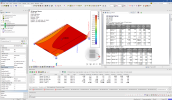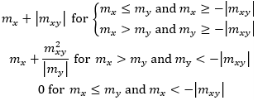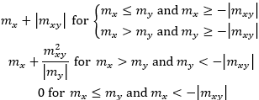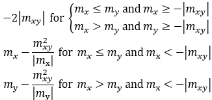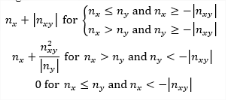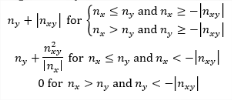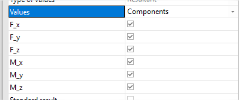2D internal forces
The 2D internal forces command serves for displaying internal forces on selected 2D members.
Usage
- Calculate a FEM analysis of the model
- Go to Tree > Results > 2D members > 2D internal forces
- Set properties of the command to specify mainly:
- Click on [Refresh] action button to display the results
Note: To get general overview about how to work with a Result service and its commands, see Results/Basics.
Properties
| Category | Property | Description / Notes |
|---|---|---|
| Selection |
Type of selection
|
Specifies on what members the results are displayed
|
| Filter
No / Material / WildCard / Layer / Thickness |
||
| Result case |
Type of load
|
Defines for what load the results are displayed. See "Result case" |
| Extreme |
Averaging of peak
|
Activates averaging of peaks of results in places where averaging strips are applied. |
|
Rib
|
Controls whether the components of internal forces parallel with the direction of the rib are neglect in area of effective width (the forces are recalculated to 1D results of the rib instead). See Results/Theory/Rib_option |
|
| Location
In centres / In nodes no avg. / In nodes avg. / In nodes avg. on macro |
Determines way how results - calculated in the nodes of individual finite elements - are further processed (averaged) to get smoother continuous distribution. |
|
|
System
|
Sets a coordination system which is used as referenced for displaying the results. See Results/Theory/Local_axes_2d |
|
|
Extreme Mesh / Member / Global |
Defines for which extreme on 2D member the results are displayed. | |
| Type of values
Basic magnitudes / Principal magnitudes / Elementary design magnitudes / Resultant |
||
| Value | See table Values below. | |
| Standard result
On/Off |
Display standard results on 2D members. | |
| Results on sections
On/Off |
Display results on defined sections on 2D members. | |
| Results on edges
On/Off |
Display results on the edges of selected 2D members. | |
| Drawing Setup 2D | "Drawing setup 2D" | |
| Errors, warnings and notes settings | "Errors, warnings and notes settings" |
Values
The following categories of internal forces can be displayed:
Basic magnitudes
The basic internal forces are default magnitudes referring to the local axes of the selected coordination system.
| Value | Description | Notes |
|---|---|---|
| mx |
bending moment in direction of local axis x |
1) As default, the internal forces refer to the local axes of the individual finite (mesh) elements. 2) The local axes can be displayed by selecting the corresponding option in the View parameters settings.
|
| my | bending moment in direction of local axis y | |
| mxy | torsional moment | |
| vx | shear force in direction of local axis x | |
| vy | shear force in direction of local axis y | |
| nx | axial force in direction of local axis x | |
| ny | axial force in direction of local axis y | |
| nxy | in-plane shear force |
Principal magnitudes
The principal internal forces represent the extreme values of the internal forces derived from the basic ones by transformation into the directions of principal axes:
| Value | Description | Notes |
|---|---|---|
| m1 |
principal bending moment (max) |
1) The angles of principal magnitudes are derived from to the local axis x. 2)The principal magnitudes can be visualized also as trajectories (see the option Trajectories in the command properties). |
| m2 |
principal bending moment (min) |
|
| ab |
angle of principal bending moment m1 |
|
| mtmaxb |
maximum torsional moment |
|
| qmaxb |
maximum shear force (from bending components) |
|
| bb |
angle of maximum shear force qmaxb |
|
| n1 |
principal axial force (max) |
|
| n2 |
principal axial force (min) |
|
| am |
angle of principal axial force n1 |
|
| qmaxm |
Elementary design magnitudes
The elementary design magnitudes represent design moments/membrane forces in directions of reinforcement considered as orthogonal and in alignment with the reference local axes (x,y). The calculation is based on the normal yield criterion referred as the Wood-Armer method [1] mentioned by ENV 1992-1-1, Appendix 2. Such solution provides sufficiently accurate results for manual design of plates/walls with just pure bending/axial loading without a significant torsion.
For type of structures with mixture of bending and axial loading (shells), with high torsional moments or in case the reinforcement is somehow rotated (skewed), a more advanced approach is required. Users with access to the Concrete module can use the design forces available there based on more sophisticated Baumann theory [2], see Concrete/2D members/Internal forces 2D.
Be aware, the elementary design magnitudes must not be combined! The design moments exclusively refer to design of plate reinforcement while design membrane forces are based on design of reinforcement in walls.
Resultant
| Value | Description | Notes |
|---|---|---|
| Fx |
resultants of internal forces in direction of local axis x |
|
| Fy | resultants of internal forces in direction of local axis y | |
| Fz | resultants of internal forces in direction of local axis z | |
| Mx | resultants of internal forces around local axis x | |
| My | resultants of internal forces around local axis y | |
| Mz | resultants of internal forces around local axis z | |
| Components |
possibility to choose more components in same time |

